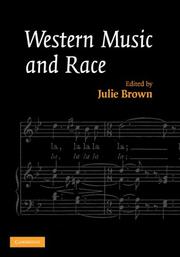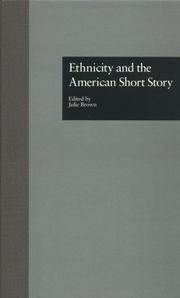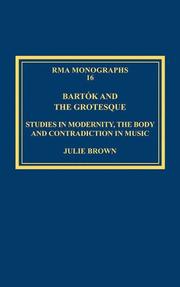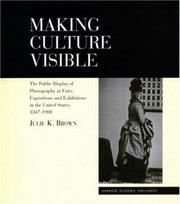| Listing 1 - 10 of 28 | << page >> |
Sort by
|

ISBN: 9780521838870 0521838878 Year: 2007 Publisher: Cambridge Cambridge university press
Abstract | Keywords | Export | Availability | Bookmark
 Loading...
Loading...Choose an application
- Reference Manager
- EndNote
- RefWorks (Direct export to RefWorks)
Music and race. --- Music --- Musique et race --- Musique --- History and criticism. --- Histoire et critique --- Music and race --- Race and music --- Race --- History and criticism
Book
ISBN: 9780521550352 9781139048934 9781139957397 1139957392 1139048937 0521550351 1139948911 1139949969 1139961624 1139960571 1139956329 1139958453 1139959506 1108722075 1322066299 Year: 2014 Publisher: New York
Abstract | Keywords | Export | Availability | Bookmark
 Loading...
Loading...Choose an application
- Reference Manager
- EndNote
- RefWorks (Direct export to RefWorks)
Schoenberg and Redemption presents a new way of understanding Schoenberg's step into atonality in 1908. Reconsidering his threshold and early atonal works, as well as his theoretical writings and a range of previously unexplored archival documents, Julie Brown argues that Schoenberg's revolutionary step was in part a response to Wagner's negative charges concerning the Jewish influence on German music. In 1898 and especially 1908 Schoenberg's Jewish identity came into confrontation with his commitment to Wagnerian modernism to provide an impetus to his radical innovations. While acknowledging the broader turn-of-the-century Viennese context, Brown draws special attention to continuities between Schoenberg's work and that of Viennese moral philosopher Otto Weininger, himself an ideological Wagnerian. She also considers the afterlife of the composer's ideological position when, in the late 1920s and early 1930s, the concept of redeeming German culture of its Jewish elements took a very different turn.
Redemption. --- Schoenberg, Arnold, --- Criticism and interpretation. --- Redemption --- Religion --- Shenberg, Arnolʹd, --- Schönberg, Arnold, --- Schenberg, A. --- Shenberg, A. --- שנברג, ארנולד --- Schönberg, Arnold
Book
ISBN: 1282750097 9786612750090 085700218X 9780857002181 9781843109136 1843109131 9781282750098 661275009X Year: 2010 Publisher: London Philadelphia Jessica Kingsley Publishers
Abstract | Keywords | Export | Availability | Bookmark
 Loading...
Loading...Choose an application
- Reference Manager
- EndNote
- RefWorks (Direct export to RefWorks)
Some of the world's most celebrated authors indicate signs of autism and AS. Through analysis of biographies, autobiographies, letters and diaries, Professor Julie Brown identifies literary talents who display characteristics of Autistic Spectrum Disorder (ASD) and uncovers the similarities in their writing that suggest atypical, autistic brains.
Autism in literature. --- People with disabilities, Writings of, American --- People with disabilities, Writings of, English --- Authors with disabilities --- People with disabilities --- English people with disabilities, Writings of --- Physically handicapped, Writings of the, English --- English literature --- American people with disabilities, Writings of --- Physically handicapped, Writings of the, American --- American literature --- History and criticism. --- Biography

ISBN: 0203775198 0815321058 1134822227 1134822294 Year: 1997 Publisher: New York : Garland Pub.,
Abstract | Keywords | Export | Availability | Bookmark
 Loading...
Loading...Choose an application
- Reference Manager
- EndNote
- RefWorks (Direct export to RefWorks)
How do different ethnic groups approach the short story form? Do different groups develop culture-related themes? Do oral traditions within a particular culture shape the way in which written stories are told? Why does ""the community"" loom so large in ethnic stories? How do such traditional forms as African American slave narratives or the Chinese talk-story shape the modern short story? Which writers of color should be added to the canon? Why have some minority writers been ignored for such a long time? How does a person of color write for white publishers, editors, and readers?Each
American fiction --- Minorities --- Short stories, American --- Ethnic groups in literature. --- Minorities in literature. --- Ethnicity in literature. --- Minority authors --- History and criticism. --- Intellectual life.
Book
ISBN: 9780815321057 Year: 1997 Publisher: New York Taylor and Francis Group
Abstract | Keywords | Export | Availability | Bookmark
 Loading...
Loading...Choose an application
- Reference Manager
- EndNote
- RefWorks (Direct export to RefWorks)
Book
ISBN: 9056176056 Year: 2004 Publisher: Leuven Van Halewyck
Abstract | Keywords | Export | Availability | Bookmark
 Loading...
Loading...Choose an application
- Reference Manager
- EndNote
- RefWorks (Direct export to RefWorks)
Social organizations --- Belgium --- Aide aux pays en voie de développement --- Ontwikkelingshulp
Book
ISBN: 9780262026574 0262026570 9786612694332 0262258633 1282694332 9780262258630 Year: 2009 Publisher: Cambridge, Mass. MIT Press
Abstract | Keywords | Export | Availability | Bookmark
 Loading...
Loading...Choose an application
- Reference Manager
- EndNote
- RefWorks (Direct export to RefWorks)
This work offers a book-length examination of how international expositions, through their exhibits and infrastructures, sought to demonstrate innovations in applied health and medical practice.
Public health --- Medicine --- Exhibitions --- Santé publique --- Médecine --- Expositions --- History --- Histoire --- MEDICAL --- Public Health --- Exhibits as Topic --- Sanitation --- Communicable Disease Control --- United States --- History, 19th Century --- History, 20th Century --- Military Medicine --- Humanities --- Environment and Public Health --- History, Modern 1601 --- -Medicine --- Audiovisual Aids --- North America --- Public Health Practice --- Health --- Environmental Health --- Americas --- Teaching Materials --- Population Characteristics --- Health Occupations --- Educational Technology --- Health Care --- Disciplines and Occupations --- Technology --- Geographic Locations --- Communications Media --- Information Science --- Technology, Industry, and Agriculture --- Geographicals --- Technology, Industry, Agriculture --- Public Health - General --- Health & Biological Sciences --- Santé publique --- Médecine --- Exhibits --- Expos (Exhibitions) --- Industrial arts --- Industrial exhibitions --- International exhibitions --- World's fairs --- Clinical sciences --- Medical profession --- Community health --- Health services --- Hygiene, Public --- Hygiene, Social --- Public health services --- Public hygiene --- Sanitary affairs --- Social hygiene --- Human services --- Biosecurity --- Health literacy --- Medicine, Preventive --- National health services --- Human biology --- Life sciences --- Medical sciences --- Pathology --- Physicians --- Sales promotion --- Fairs --- Exhibitions&delete& --- History. --- Health Workforce --- SCIENCE, TECHNOLOGY & SOCIETY/History of Science --- BIOMEDICAL SCIENCES/General --- SCIENCE, TECHNOLOGY & SOCIETY/General

ISBN: 9780754657774 0754657779 9781315096599 9781351574556 Year: 2010 Publisher: Farnham Burlington Ashgate
Abstract | Keywords | Export | Availability | Bookmark
 Loading...
Loading...Choose an application
- Reference Manager
- EndNote
- RefWorks (Direct export to RefWorks)
The grotesque is one of art's most puzzling figures - transgressive, comprising an unresolveable hybrid, generally focussing on the human body, full of hyperbole, and ultimately semantically deeply puzzling. In Bluebeard's Castle (1911), The Wooden Prince (1916/17), The Miraculous Mandarin (1919/24, rev. 1931) and Cantata Profana (1930), Bartók engaged scenarios featuring either overtly grotesque bodies or closely related transformations and violations of the body. In a number of instrumental works he also overtly engaged grotesque satirical strategies, sometimes - as in Two Portraits: 'Ideal' and 'Grotesque' - indicating this in the title. In this book, Julie Brown argues that Bartók's concerns with stylistic hybridity (high-low, East-West, tonal-atonal-modal), the body, and the grotesque are inter-connected. While Bartók developed each interest in highly individual ways, and did so separately to a considerable extent, the three concerns remained conceptually interlinked. All three were thoroughly implicated in cultural constructions of the Modern during the period in which Bartók was composing.
Grotesque in music. --- Music --- Grotesque dans la musique --- Musique --- History and criticism --- Histoire et critique --- Bartók, Béla, --- Criticism and interpretation. --- Bartokas, B., --- Grotesque in music --- Bartók, Béla

ISBN: 9789058231390 9058231399 Year: 2001 Publisher: Amsterdam: Gordon and Breach,
Abstract | Keywords | Export | Availability | Bookmark
 Loading...
Loading...Choose an application
- Reference Manager
- EndNote
- RefWorks (Direct export to RefWorks)
Book
ISBN: 1283299615 1780524668 1780524676 9786613299611 Year: 2011 Publisher: Emerald Group Publishing Limited
Abstract | Keywords | Export | Availability | Bookmark
 Loading...
Loading...Choose an application
- Reference Manager
- EndNote
- RefWorks (Direct export to RefWorks)
| Listing 1 - 10 of 28 | << page >> |
Sort by
|

 Search
Search Feedback
Feedback About UniCat
About UniCat  Help
Help News
News